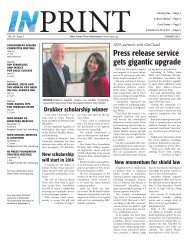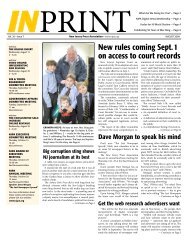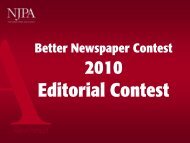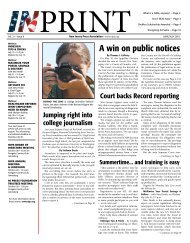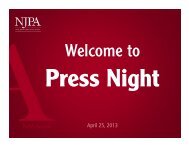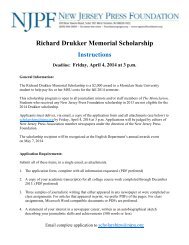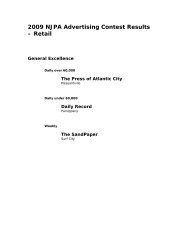establishment
Grades 5-7 - New Jersey Press Association
Grades 5-7 - New Jersey Press Association
- No tags were found...
Create successful ePaper yourself
Turn your PDF publications into a flip-book with our unique Google optimized e-Paper software.
Freedom of the Press<br />
Activity #3 - Political Cartoons<br />
Skills - Students will be able to:<br />
• Analyze current events.<br />
• Interpret symbols.<br />
Materials Needed:<br />
Several different (or same) editions of newspapers, Glue or glue sticks, Construction paper<br />
Procedure:<br />
1. Distribute several different editions of newspapers among the students.<br />
2. Ask students to find examples of political cartoons and cut them out.<br />
3. Students will paste the cartoons on construction paper and write brief explanations of the cartoons’ meanings.<br />
4. When finished, students will share the cartoons with their classmates and discuss which First Amendment Freedom(s)<br />
protects the publishing of each cartoon and/or which of the Five Freedoms is portrayed in the cartoon.<br />
Discussion Questions:<br />
• What is the event portrayed and the opinion expressed?<br />
• What symbols do you see, and why were they chosen?<br />
• What does the symbol represent to you?<br />
• What is the cartoonist’s point of view?<br />
Activity #4 - Create Your Own Political Cartoon<br />
Skill - Students will be able to: Demonstrate an understanding of a First Amendment issue in today’s society.<br />
Materials Needed:<br />
Page titled “Nine Categories of Unprotected Speech” (from the Speech Unit in this Guide).<br />
Procedure:<br />
1. Have students review the “Nine Categories of Unprotected Speech” or the teacher will review these with students.<br />
2. Students are to become a cartoonist for the newspaper. Their job is to create a political cartoon - being careful to stay within<br />
the boundaries set by the First Amendment (as contained in the “Nine Categories”).<br />
Teacher’s Note: Ideas for illustrations could include high lunch prices, crowded hallways, length of school day, bathroom<br />
location, homework policies and student workload.<br />
3. Students submit cartoons to Editor for approval. (Editor may be teacher or several students as Editorial Committee.)<br />
4. Provide students with a copy of the rubric (located in this unit).<br />
Activity #5 - Front Page Stories<br />
Skill - Students will be able to: Use inference skills to prioritize newspaper headlines.<br />
Materials Needed:<br />
A list of 10 headlines representing stories from the morning newspaper.<br />
Procedure:<br />
1. Students select five headlines for front page placement and rate each of the five in priority for appearing on Page 1.<br />
2. In small groups, students compare lists, and strive for consensus on which five headlines should appear on Page 1.<br />
3. Have a group representative present rationale for choices. Hold class discussion on the ethics of placing stories in the<br />
newspaper. Sample questions:<br />
• What responsibility does an editor have to emphasize “important” informational stories on the front page?<br />
• What responsibilities does the editor have to satisfy business interests of the newspaper by putting “sensational” stories<br />
on Page 1 to help “sell” the newspaper?<br />
• Is there a proper balance the editor can achieve between emphasizing what the reader “should read” and what the reader<br />
“wants to read”?<br />
46



